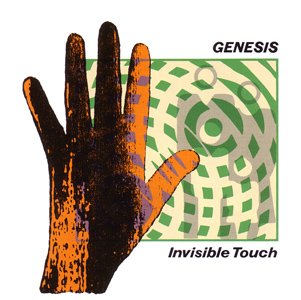Genesis, once synonymous with intricate, progressive rock epics, began in the early ’70s as one of the genre’s most inventive bands. Known for elaborate storytelling, complex time signatures, and theatrical live performances—especially during Peter Gabriel’s tenure as frontman—Genesis carved a reputation with albums like Foxtrot and The Lamb Lies Down on Broadway. These records cemented their place in progressive rock, drawing dedicated fans who admired the band’s artistry and ambition.
However, by the mid-1980s, Genesis had transformed. With Phil Collins now firmly at the helm, both as frontman and a rising pop star in his solo career, the band started experimenting with more accessible sounds and concise songwriting. This evolution culminated in Invisible Touch (1986), a sleek, hook-laden album that embraced pop sensibilities without fully abandoning their sophisticated musicality. For Genesis, Invisible Touch was a breakthrough, marking a decisive shift into the mainstream and redefining their legacy as a band unafraid to adapt, even at the risk of alienating some longtime fans.
Background: Genesis Before ‘Invisible Touch’

Before Invisible Touch, Genesis was a leading force in progressive rock, a genre defined by its complexity, theatricality, and often extended musical journeys. Albums like Foxtrot (1972) and The Lamb Lies Down on Broadway (1974) showcased Genesis’ knack for blending storytelling with elaborate, multi-layered compositions. Songs such as “Supper’s Ready” and the concept-driven Lamb Lies Down on Broadway album illustrated their signature style: unconventional song structures, surreal lyrics, and a willingness to push boundaries in both sound and subject matter.
The band’s lineup changes played a significant role in shaping its musical direction. When original frontman Peter Gabriel departed in 1975, drummer Phil Collins stepped in as lead vocalist, and with him came a subtle shift in sound. As Genesis moved through albums like A Trick of the Tail (1976) and Duke (1980), the music began to lean toward tighter arrangements and clearer melodies. Meanwhile, Collins’ success as a solo artist throughout the early ’80s brought a fresh pop sensibility and polished production techniques to the band’s work, further nudging Genesis toward mainstream appeal.
By the time they approached Invisible Touch, Genesis had already evolved significantly from their prog-rock roots, blending their penchant for musical sophistication with a newfound accessibility that would make them one of the most successful bands of the decade.
The Making of Invisible Touch
The creation of Invisible Touch saw Genesis fully embrace a collaborative, streamlined approach to songwriting and production. Teaming up once again with producer Hugh Padgham, who had worked with the band on their previous album, Genesis (1983), the trio of Phil Collins, Tony Banks, and Mike Rutherford focused on crafting songs that balanced sharp hooks with their usual sophistication. Unlike their earlier, more sprawling works, the sessions for Invisible Touch were centered around jamming and improvisation, allowing ideas to develop naturally and efficiently. This spontaneous approach led to some of the album’s most memorable tracks, including the title song, which originated from an off-the-cuff riff that quickly evolved into a pop hit.
In terms of songwriting, Invisible Touch marked a shift for Genesis toward a distinctly pop-oriented style, prioritizing accessible choruses, polished verses, and catchy refrains. Tracks like “Throwing It All Away” and “Tonight, Tonight, Tonight” were built around infectious hooks, while “Land of Confusion” leveraged an anthemic structure, underscored by a driving beat and politically charged lyrics. Padgham’s production played a crucial role in refining these elements, blending Collins’ signature gated-reverb drum sound with Banks’ lush synthesizers and Rutherford’s prominent guitar lines, all engineered to appeal to both radio and stadium audiences.
Technologically, the band employed a mix of digital synthesizers and drum machines alongside traditional instruments, enhancing the album’s sleek, modern sound. Banks’ use of the Prophet-5 and the Emulator II sampler added new textures, while Collins experimented with LinnDrum patterns, crafting a rhythmic foundation that felt simultaneously human and mechanized. These techniques, combined with Padgham’s sharp production, gave Invisible Touch a sonic clarity and energy that set it apart from Genesis’ earlier work, making it one of the defining albums of the ’80s pop-rock crossover.
Standout Tracks and Themes
Invisible Touch is packed with songs that showcase Genesis’ ability to blend pop appeal with elements of their prog-rock roots. Each track offers a distinct vibe and thematic exploration, merging personal introspection with broader societal commentary, wrapped in catchy, radio-friendly packaging.
Invisible Touch
The title track, “Invisible Touch,” is an upbeat, infectious pop song that became one of the band’s biggest hits. On the surface, it’s a straightforward love song, describing an all-consuming, magnetic attraction. Yet, beneath its bright melody and Collins’ energetic vocals, there’s a hint of obsession, reflecting the complexities and unpredictability of relationships. The song’s clean production and layered synthesizers made it instantly accessible, balancing Genesis’ past sophistication with a sleek pop sensibility.
Land of Confusion
“Land of Confusion” stands out as the album’s most socially charged track, addressing political tension and societal anxiety in the mid-1980s. With lines like “Oh, Superman, where are you now?” the song captures a sense of disillusionment, calling for accountability from world leaders and questioning the stability of global power structures. Musically, it combines a strong, syncopated beat with anthemic melodies, and its iconic music video—with puppet caricatures of political figures—became a cultural touchstone. The track is grounded in a classic rock structure, but the tight arrangements and polished production exemplify the band’s shift toward mainstream rock.
Tonight, Tonight, Tonight
“Tonight, Tonight, Tonight” leans into Genesis’ prog-rock heritage, stretching past eight minutes on the album version and featuring an atmospheric build-up with layered synthesizers and intricate drum patterns. Lyrically, the song explores themes of desperation and escapism, often interpreted as depicting struggles with addiction and the desire to break free from personal turmoil. While the song’s extended instrumental sections and brooding mood harken back to Genesis’ progressive roots, its dynamic production and memorable chorus make it accessible to a wider audience, striking a balance between introspection and pop appeal.
Chart Success and Critical Reception
Invisible Touch was a commercial triumph, solidifying Genesis’ presence in the mainstream music scene. Released in 1986, the album reached No. 3 on the UK Albums Chart and climbed to No. 3 on the US Billboard 200, eventually becoming the band’s best-selling album in both regions. It produced five Top 5 singles in the U.S.—the title track “Invisible Touch” hit No. 1, making it Genesis’ first (and only) single to top the Billboard Hot 100. Other singles like “Throwing It All Away” and “Land of Confusion” also secured high chart positions, bolstered by heavy radio play and popular music videos that showcased the band’s new image.
Critically, Invisible Touch sparked mixed reactions. On one hand, it was celebrated by mainstream outlets for its polished production, catchy hooks, and crossover appeal, with critics praising the band’s ability to craft pop hits without losing their identity entirely. Many lauded Phil Collins’ vocal charisma and the band’s skillful blend of synthesizers, guitar, and innovative drumming. However, the album’s pivot to pop disappointed some longtime fans who preferred the complex arrangements and ambitious storytelling of Genesis’ prog-rock era. Some critics viewed the album’s polished sound as a step too far toward commercialism, arguing it lacked the depth of the band’s earlier work.
Despite the mixed critical reception, Invisible Touch succeeded in reshaping Genesis’ legacy, proving they could appeal to a broad audience while retaining the musicality that had defined them. The album’s success cemented Genesis as one of the defining acts of the ’80s, bridging the gap between art rock and mainstream pop with surprising finesse.
Closing Thoughts
Invisible Touch marked a defining moment in Genesis’ journey, showcasing their evolution from progressive rock pioneers to mainstream pop icons. The album symbolized a bold departure, blending their sophisticated musical roots with a polished, pop-oriented approach that captured a massive audience in the ’80s. While the shift divided some longtime fans, it also brought Genesis unprecedented commercial success, proving that a band known for complex, artful compositions could adapt to the changing musical landscape without losing their creative edge.
